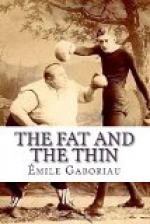Fruits of all kinds were piled around her in her narrow stall. On the shelves at the back were rows of melons, so-called “cantaloups” swarming with wart-like knots, “maraichers” whose skin was covered with grey lace-like netting, and “culs-de-singe” displaying smooth bare bumps. In front was an array of choice fruits, carefully arranged in baskets, and showing like smooth round cheeks seeking to hide themselves, or glimpses of sweet childish faces, half veiled by leaves. Especially was this the case with the peaches, the blushing peaches of Montreuil, with skin as delicate and clear as that of northern maidens, and the yellow, sun-burnt peaches from the south, brown like the damsels of Provence. The apricots, on their beds of moss, gleamed with the hue of amber or with that sunset glow which so warmly colours the necks of brunettes at the nape, just under the little wavy curls which fall below the chignon. The cherries, ranged one by one, resembled the short lips of smiling Chinese girls; the Montmorencies suggested the dumpy mouths of buxom women; the English ones were longer and graver-looking; the common black ones seemed as though they had been bruised and crushed by kisses; while the white-hearts, with their patches of rose and white, appeared to smile with mingled merriment and vexation. Then piles of apples and pears, built up with architectural symmetry, often in pyramids, displayed the ruddy glow of budding breasts and the gleaming sheen of shoulders, quite a show of nudity, lurking modestly behind a screen of fern-leaves. There were all sorts of varieties—little red ones so tiny that they seemed to be yet in the cradle, shapeless “rambours” for baking, “calvilles” in light yellow gowns, sanguineous-looking “Canadas,” blotched “chataignier” apples, fair freckled rennets and dusky russets. Then came the pears—the “blanquettes,” the “British queens,” the “Beurres,” the “messirejeans,” and the “duchesses”—some dumpy, some long and tapering, some with slender necks, and others with thick-set shoulders, their green and yellow bellies picked out at times with a splotch of carmine. By the side of these the transparent plums resembled tender, chlorotic virgins; the greengages and the Orleans plums paled as with modest innocence, while the mirabelles lay like golden beads of a rosary forgotten in a box amongst sticks of vanilla. And the strawberries exhaled a sweet perfume—a perfume of youth—especially those little ones which are gathered in the woods, and which are far more aromatic than the large ones grown in gardens, for these breathe an insipid odour suggestive of the watering-pot. Raspberries added their fragrance to the pure scent. The currants—red, white, and black—smiled with a knowing air; whilst the heavy clusters of grapes, laden with intoxication, lay languorously at the edges of their wicker baskets, over the sides of which dangled some of the berries, scorched by the hot caresses of the voluptuous sun.




